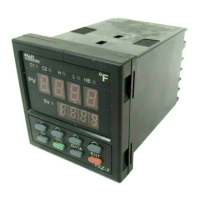P-An Alarm Hysteresis: The Alarm Hysteresis is that area
on one side of the alarm setpoint where the output
does not change condition. That area or deadband is
intended to eliminate relay chatter at alarm setpoint
with less wear on the relay. With a wide Alarm
Hysteresis, the controller takes a longer time to
change output condition. With a narrow Alarm
Hysteresis, the controller takes a short time to change
output condition. Enter a value which is just large
enough to eliminate relay chatter.
Setting Range: 0 to 50% of full scale, set in E.U.
P-dP Decimal Point Position (Resolution): The Decimal
Point Position is the resolution at which the PXZ con-
troller displays the process variable and other para-
meter values. The PXZ can indicate integers, tenths or
hundredths of a unit. The Decimal Point Position does
not increase the accuracy of the controller, it only
increases the resolution. For a thermocouple, integers
are usually sufficient due to the accuracy rating and
the programmed input range. For a RTD (Pt100), inte-
gers or tenths of a degree may be entered, because of
the increased accuracy of these sensors, depending
on the programmed input range. For a 1-5/0-5V DC or
4-20/0-20mA DC signal, integers, tenths or hundredths
of a unit may be entered depending on the pro-
14
P-AL Alarm Type 2:
P-AH Alarm Type 1: This function sets the control action for
the optional alarm output relays. The PXZ5, 7, and 9
comes with two relays while the PXZ4 comes with
one. They can be programmed for absolute, deviation,
combination, or zone alarm configuration. The high
and low alarm setpoints are set with primary menu
parameters AH and AL. The absolute alarm configura-
tions are independent of main setpoint. The alarm out-
put relays are energized when the process variable
exceeds the alarm setpoint, an absolute value. The
deviation alarm configuration is main setpoint track-
ing. The alarm output relays are energized when the
process variable exceeds the main setpoint by a devi-
ation value set by AL or AH. The combination alarm
configurations are a mixture of both the deviation and
absolute value settings for the high and low alarms.
With zone alarm configurations the alarm output is
energized between the range set by AL and AH.
One of the alarm types is Alarm with Hold. In this case
the alarm is not turned on the first time the measured
value is in the alarm band. Instead it turns on only
when the measured value goes out of the band and
enters it again. This type is useful when using devia-
tion alarm with step type input.
Enter the code for P-AH and P-AL from the Table of
Alarm Action Type Codes.
Note 1: A change of alarm action type can cause the
alarm set value to change, but this is not a malfunction.
Note 2: After the alarm type is changed, turn off the
power to the unit once.
32 . . . . . . . . . . . . .1472 °F
Program a 4-20mA DC signal for 0 to 100 E.U.
-1999 . . . 9999 Enginerring Units
Artisan Technology Group - Quality Instrumentation ... Guaranteed | (888) 88-SOURCE | www.artisantg.com

